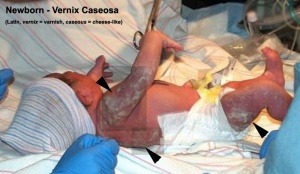Integumentary System Development - Vernix Caseosa: Difference between revisions
mNo edit summary |
mNo edit summary |
||
| Line 23: | Line 23: | ||
* '''Skin barrier in the neonate'''{{#pmid:29596733|PMID29596733}} "The purpose of this review is to focus on determinants of skin barrier function in neonates at molecular and cellular levels. The skin barrier is critical in terms of water and gas exchanges during fetal life and undergoes rapid changes at birth, followed by a progressive maturation. Consequences of skin barrier disruption can be extremely detrimental or lethal, as shown in severe genetic epidermal defects. In this context, the fine-tuned rapid adaptation from a liquid to a gaseous milieu is not fully understood. The stratum corneum provides an air-liquid barrier, tight junctions in the granular layer provide a liquid-liquid barrier, aquaporins represent a plumbing system for water-glycerol as well as gas exchanges, and Langerhans cells are central to the immunological barrier. Acid mantle formation is essential for appropriate interaction between the skin and microbial symbionts. Temperature and pH regulate the key enzyme activities responsible for the integrity of the stratum corneum. Skin barrier permeability can be assessed noninvasively and simply with miniaturized devices measuring transepidermal water loss, where water flow is faster in cases of a damaged or functionally premature barrier. New avenues for therapeutic skin barrier research in neonates include a better delineation of the maturation of aquaporins in water balance and gas exchanges from fetal to neonatal life and a better understanding of the role of vernix caseosa, in particular, for the implantation of a healthy microbiote. Practical applications should be derived for caring for infant skin, particularly in fragile zones, such as the diaper area." {{neonatal}} | * '''Skin barrier in the neonate'''{{#pmid:29596733|PMID29596733}} "The purpose of this review is to focus on determinants of skin barrier function in neonates at molecular and cellular levels. The skin barrier is critical in terms of water and gas exchanges during fetal life and undergoes rapid changes at birth, followed by a progressive maturation. Consequences of skin barrier disruption can be extremely detrimental or lethal, as shown in severe genetic epidermal defects. In this context, the fine-tuned rapid adaptation from a liquid to a gaseous milieu is not fully understood. The stratum corneum provides an air-liquid barrier, tight junctions in the granular layer provide a liquid-liquid barrier, aquaporins represent a plumbing system for water-glycerol as well as gas exchanges, and Langerhans cells are central to the immunological barrier. Acid mantle formation is essential for appropriate interaction between the skin and microbial symbionts. Temperature and pH regulate the key enzyme activities responsible for the integrity of the stratum corneum. Skin barrier permeability can be assessed noninvasively and simply with miniaturized devices measuring transepidermal water loss, where water flow is faster in cases of a damaged or functionally premature barrier. New avenues for therapeutic skin barrier research in neonates include a better delineation of the maturation of aquaporins in water balance and gas exchanges from fetal to neonatal life and a better understanding of the role of vernix caseosa, in particular, for the implantation of a healthy microbiote. Practical applications should be derived for caring for infant skin, particularly in fragile zones, such as the diaper area." {{neonatal}} | ||
* '''Newborn boys and girls differ in the lipid composition of vernix caseosa'''{{#pmid:24911066|PMID24911066}} "Vernix caseosa protects the skin of a human fetus during the last trimester of pregnancy and of a newborn after the delivery. Besides its cellular and proteinaceous components, an important constituent and functional agent is a complex lipid fraction, implicated in a multitude of salubrious effects of vernix caseosa. Little is known about how the chemical composition of vernix caseosa lipids is affected by various biological characteristics of the baby, such as the gestational age, birth weight, and, last but not least, the gender of the newborn. This study reports on the chemical variability of lipids contained in the vernix caseosa of twenty newborn girls and boys and shows that the quantitative patterns of the lipids are sex-specific. The specificity of lipids was investigated at the level of fatty acids in the total lipid extracts and intact lipids of several neutral lipid classes. Hydrocarbons, wax esters, cholesteryl esters, diol diesters and triacylglycerols were isolated using optimized semipreparative thin-layer chromatography, and the molecular species within each class were characterized using matrix-assisted laser desorption/ionization mass spectrometry. Statistical evaluation revealed significant quantitative sex-related differences in the lipid composition of vernix caseosa among the newborns, pronounced in the two lipid classes associated with the activity of sebaceous glands. Higher proportions of wax esters and triacylglycerols with longer hydrocarbon chains were observed in newborn girls." | |||
|} | |} | ||
{| class="wikitable mw-collapsible mw-collapsed" | {| class="wikitable mw-collapsible mw-collapsed" | ||
Revision as of 11:00, 9 August 2018
| Embryology - 18 Apr 2024 |
|---|
| Google Translate - select your language from the list shown below (this will open a new external page) |
|
العربية | català | 中文 | 中國傳統的 | français | Deutsche | עִברִית | हिंदी | bahasa Indonesia | italiano | 日本語 | 한국어 | မြန်မာ | Pilipino | Polskie | português | ਪੰਜਾਬੀ ਦੇ | Română | русский | Español | Swahili | Svensk | ไทย | Türkçe | اردو | ייִדיש | Tiếng Việt These external translations are automated and may not be accurate. (More? About Translations) |
Introduction
The vernix caseosa has several different potential functions and a variable composition.[1]
- a highly variable coating of the fetal skin
- high water content (80%) largely compartmentalized within fetal corneocytes (cells forming the stratum corneum)
- develops cranio-caudally production coincides in utero with terminal differentiation of the epidermis and formation of the stratum corneum
- primarily composed of sebum, cells that have sloughed off the fetus's skin and shed lanugo hair
- can be absent in preterm infants
- dehydration and rehydration processes occur two to four times faster at 37 degrees celcius than at room temperature[2]
- towards term fragments of vernix can mix into the amniotic fluid resulting in (normal) turbidity
- fetal swallowing of amniotic fluid mixed with fragments of vernix can also occur
- cathelicidin LL-37, alpha-defensins, and LL-37 in neutrophils.[3]
Some Recent Findings
|
| More recent papers |
|---|
|
This table allows an automated computer search of the external PubMed database using the listed "Search term" text link.
More? References | Discussion Page | Journal Searches | 2019 References | 2020 References Search term: Vernix Caseosa <pubmed limit=5>Vernix Caseosa</pubmed> |
Textbooks
- Human Embryology (2nd ed.) Larson Chapter 14 p443-455
- The Developing Human: Clinically Oriented Embryology (6th ed.) Moore and Persaud Chapter 20: P513-529
- Before We Are Born (5th ed.) Moore and Persaud Chapter 21: P481-496
- Essentials of Human Embryology Larson Chapter 14: P303-315
- Human Embryology, Fitzgerald and Fitzgerald
- Color Atlas of Clinical Embryology Moore Persaud and Shiota Chapter 15: p231-236
Integumentary Development Overview
4 weeks
- simple ectoderm epithelium over mesenchyme.
1-3 months
|
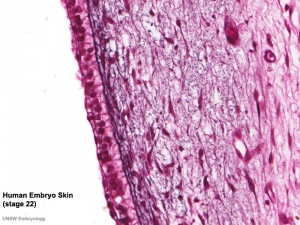
Integument Human Embryo (Week 8, Stage 22) |
4 months
Fetal human integumentary histology[7](Weeks in figure are from LMP)
- Basal cell - proliferation generates folds in basement membrane.
- Neural crest cells - melanoblasts migrate into epithelium. These are the future melanocyte pigment cell of the skin.
- Embryonic connective tissue- differentiates into dermis, a loose ct layer over a dense ct layer. Beneath the dense ct layer is another loose ct layer that will form the subcutaneous layer.
- Ectoderm contributes to nails, hair follictles and glands.
- Nails form as thickening of ectoderm epidermis at the tips of fingers and toes. These form germinative cells of nail field.
- Cords of these cells extend into mesoderm forming epithelial columns. These form hair follicles, sebaceous and sweat glands.
5 months
- Hair growth initiated at base of cord, lateral outgrowths form associated sebaceous glands.
- Other cords elongate and coil to form sweat glands.
- Cords in mammary region branch as they elongate to form mammary glands. These glands will complete development in females at puberty. Functional maturity only occurs in late pregnancy.
Embryonic and Fetal Epidermis
Electron Micrographs of the Developing Human Epidermis[8]
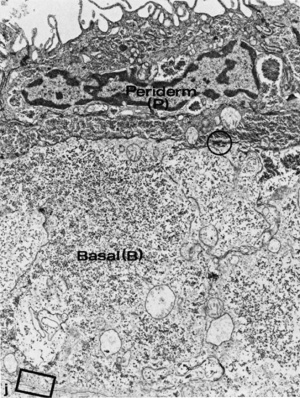
6 to 8 weeks (8-9 week EGA) |
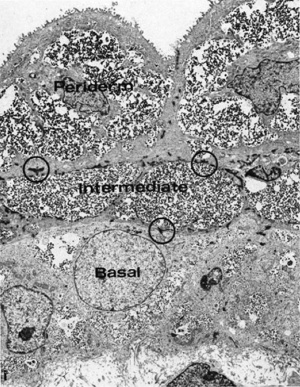
7 to 9 weeks (9-11 week EGA) |
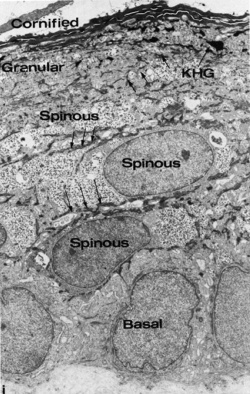
22 weeks (about 24 week EGA) |
References
- ↑ Pickens WL, Warner RR, Boissy YL, Boissy RE & Hoath SB. (2000). Characterization of vernix caseosa: water content, morphology, and elemental analysis. J. Invest. Dermatol. , 115, 875-81. PMID: 11069626 DOI.
- ↑ Rissmann R, Groenink HW, Gooris GS, Oudshoorn MH, Hennink WE, Ponec M & Bouwstra JA. (2008). Temperature-induced changes in structural and physicochemical properties of vernix caseosa. J. Invest. Dermatol. , 128, 292-9. PMID: 17671513 DOI.
- ↑ Yoshio H, Lagercrantz H, Gudmundsson GH & Agerberth B. (2004). First line of defense in early human life. Semin. Perinatol. , 28, 304-11. PMID: 15565791
- ↑ Taïeb A. (2018). Skin barrier in the neonate. Pediatr Dermatol , 35 Suppl 1, s5-s9. PMID: 29596733 DOI.
- ↑ Míková R, Vrkoslav V, Hanus R, Háková E, Hábová Z, Doležal A, Plavka R, Coufal P & Cvačka J. (2014). Newborn boys and girls differ in the lipid composition of vernix caseosa. PLoS ONE , 9, e99173. PMID: 24911066 DOI.
- ↑ Fuchs E. (2008). Skin stem cells: rising to the surface. J. Cell Biol. , 180, 273-84. PMID: 18209104 DOI.
- ↑ 7.0 7.1 Coolen NA, Schouten KC, Middelkoop E & Ulrich MM. (2010). Comparison between human fetal and adult skin. Arch. Dermatol. Res. , 302, 47-55. PMID: 19701759 DOI.
- ↑ Dale BA, Holbrook KA, Kimball JR, Hoff M & Sun TT. (1985). Expression of epidermal keratins and filaggrin during human fetal skin development. J. Cell Biol. , 101, 1257-69. PMID: 2413039
Reviews
Visscher MO, Adam R, Brink S & Odio M. (2015). Newborn infant skin: physiology, development, and care. Clin. Dermatol. , 33, 271-80. PMID: 25889127 DOI.
Singh G & Archana G. (2008). Unraveling the mystery of vernix caseosa. Indian J Dermatol , 53, 54-60. PMID: 19881987 DOI.
Articles
Kalužíková A, Vrkoslav V, Harazim E, Hoskovec M, Plavka R, Buděšínský M, Bosáková Z & Cvačka J. (2017). Cholesteryl esters of ω-(O-acyl)-hydroxy fatty acids in vernix caseosa. J. Lipid Res. , 58, 1579-1590. PMID: 28576934 DOI.
Search PubMed
Search Pubmed: Vernix Caseosa
NCBI - Policies and Guidelines | PubMed | Help:Reference Tutorial
Additional Images
Historic
| Historic Disclaimer - information about historic embryology pages |
|---|
| Pages where the terms "Historic" (textbooks, papers, people, recommendations) appear on this site, and sections within pages where this disclaimer appears, indicate that the content and scientific understanding are specific to the time of publication. This means that while some scientific descriptions are still accurate, the terminology and interpretation of the developmental mechanisms reflect the understanding at the time of original publication and those of the preceding periods, these terms, interpretations and recommendations may not reflect our current scientific understanding. (More? Embryology History | Historic Embryology Papers) |
Terms
| Integumentary Terms | ||
|---|---|---|
Integumentary Development
| ||
|
External Links
External Links Notice - The dynamic nature of the internet may mean that some of these listed links may no longer function. If the link no longer works search the web with the link text or name. Links to any external commercial sites are provided for information purposes only and should never be considered an endorsement. UNSW Embryology is provided as an educational resource with no clinical information or commercial affiliation.
Glossary Links
- Glossary: A | B | C | D | E | F | G | H | I | J | K | L | M | N | O | P | Q | R | S | T | U | V | W | X | Y | Z | Numbers | Symbols | Term Link
Cite this page: Hill, M.A. (2024, April 18) Embryology Integumentary System Development - Vernix Caseosa. Retrieved from https://embryology.med.unsw.edu.au/embryology/index.php/Integumentary_System_Development_-_Vernix_Caseosa
- © Dr Mark Hill 2024, UNSW Embryology ISBN: 978 0 7334 2609 4 - UNSW CRICOS Provider Code No. 00098G
